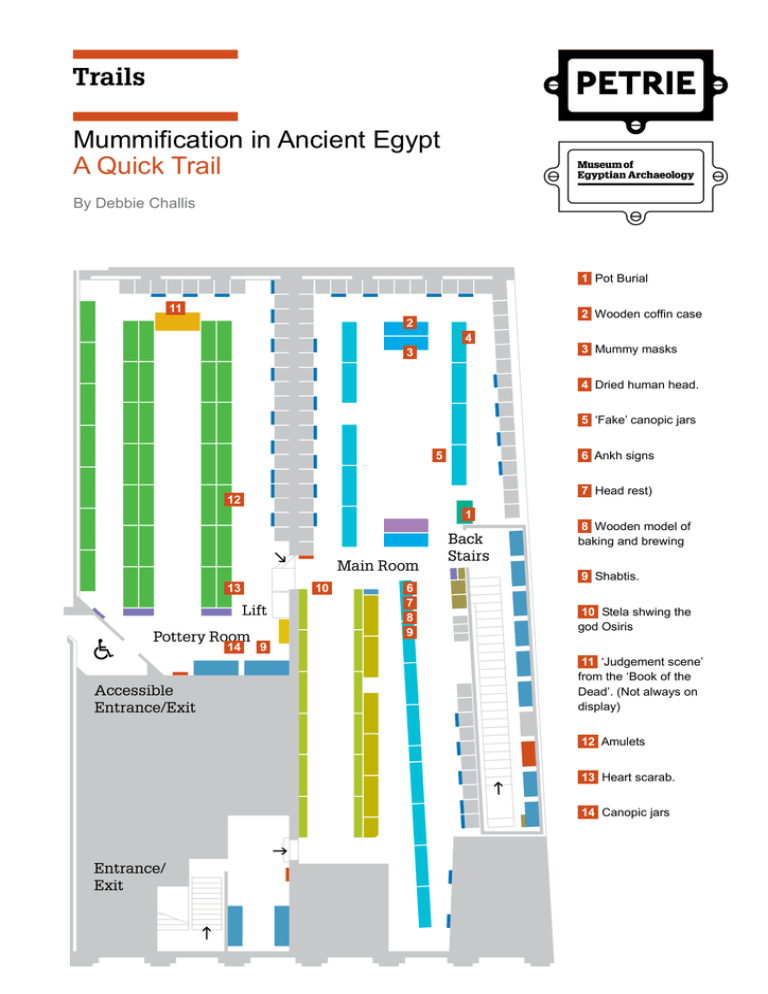Mummification in Ancient Egypt A Quick Trail By Debbie Challis
advertisement

Mummification in Ancient Egypt A Quick Trail By Debbie Challis 1 Pot Burial 11 2 Wooden coffin case 2 4 3 Mummy masks 3 4 Dried human head. 5 ‘Fake’ canopic jars 5 6 Ankh signs 7 Head rest) 12 1 8 Wooden model of baking and brewing 9 Shabtis. 13 14 10 6 7 8 9 10 Stela shwing the god Osiris 9 11 ‘Judgement scene’ from the ‘Book of the Dead’. (Not always on display) 12 Amulets 13 Heart scarab. 14 Canopic jars Burial Customs 1 This Pot Burial illustrates how some people were buried in the period of Egypt before the Pharaohs, or predynastic Egypt. This burial comes from an area of Egypt known as Badari, which was the place for one of the earliest farming communities. In this period (4500 -4000 BC) the dead are placed in shallow holes. Burial goods include some vessels for containing food provision for the afterlife, jewellery as status symbols and slate palettes for preparing eye paint. Examples of these items can be seen at the bottom of the case. 2 Coffin Case. This is a wooden coffin case of the woman NAIRTESITNUFER (NA-AR-ER-AST-NEFER), which is painted with scenes and inscriptions from the ‘Book of the Dead’. It is the outer case for a mummified figure from 750-700 BC. 3 Cartonnage Masks. In this case are masks for covering the head of mummified people. Most of them are from the later Greek and Roman ruled periods of Egypt and illustrate that ancient Egyptian burial customs continued under foreign occupation. 4 Desicated Head. On the bottom of this case (Hawara), is a dried head of a woman (UC28073). It is covered with a colourful ‘sprang’ cap. 5 Canopic Jars. In this case are some pretend canopic jars. In this period (Dynasty 20,1186 -1069 BC) the mummification of the body was so good that the soft internal organs did not have to be removed as the body would not decompose. However, the custom of burying the jars with the representations of the various gods was so great that ‘dummy’ canopic jars were used instead. (UC29794-6). 6 Ankh Signs. These 4 wooden ankh signs (UC313658) would have been attached to a larger object, possibly a mummification table. The ankh was the sign of life. The tables the embalmers worked on were decorated with significant symbols to prepare the body for the afterlife and immortality. Page 2 of 4 7 Head Rest. Next to the ankh signs is a wooden Head Rest (UC 8606), which the Ancient Egyptians used for sleeping on. Mummies often had head rests placed underneath their heads so they were comfortable in their journey into the afterlife. 8 Wooden Model. Near to the Head Rest is a wooden model (UC31721) showing workers brewing and baking. It became common to place scenes of activities, possibly relevant to the deceased’s life within burial places from the Sixth Dynasty onwards. 9 Shabtis. Next to the wooden model are some shabtis. Shabtis were buried to act as servants in the afterlife. One of the shabtis (UC28415) is finely glazed with the inscription for "the charioteer Pa-neter-hen". 10 Stela. This rectangular limestone stela (like a gravestone – UC14442) shows the royal scribe Raya and Nakht, the first prophet of Sopdu, standing before the god Osiris. 11 Book of the Dead. In this case is a linen bandage fragment (UC32444) with hieratic caption of seven (or eight?) lines of the ‘Book of the Dead’ judgement scene. The Book of the Dead is the modern name for ancient Egyptian manuscripts that have a series of scenes and incantations for entering the afterlife. Individual chapters occur on other funerary equipment, such as shabtis, amulets, the heart scarab, and on the coffins, sarcophagi and walls of burial chambers and offering chapels. Book of the Dead judgement scene (UC32444). Page 3 of 4 12 Amulets. Amulets are laid out here in the exact position that they were found in the wrappings of a mummy of the Tomb of Horuta in Hawara. 13 Heart Scarab. These three objects (UC12577) comprise a crystal cover, inscribed inside in black with bennu bird and inscription, a plaster lining with resin and gold foil and an opaque glass plate which together formed a heart. A ‘Heart Scarab’ would have been wrapped in the mummy bandages over the heart of the deceased. It was usually inscribed with a chapter (30B) from the Book of the Dead to assist with the weighing of the heart in the judgement before Osiris in the afterlife. 14 Canopic Jars. In this case are real canopic jars that were used for storing human organs so that the soft part of the body would not decompose and ruin the rest of the preserved body. Some Further Reading British Museum, My Egyptian Mummy File Joyce Tyldesley, The Mummy John Taylor, Unwrapping an Egyptian Mummy Page 4 of 4






